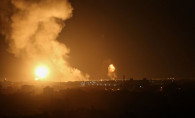Cholera sweeps NE Syria
Cholera sweeps NE Syria
Cholera disease has swept through northeastern Syria, claiming the lives of dozens of people and infecting hundreds of others, amid fears of striking other areas of the country.
Cholera is a disease caused by a bacterial infection via contaminated food or drinks, causing acute watery diarrhea that could lead to dehydration. It affects children and adults alike, and symptoms appear from 12 hours to 5 days, according to the World Health Organization (WHO).
According to data from the Syrian Ministry of Health as of September 17, the number of cholera cases recorded 201, including 153 in Aleppo, 21 in Hasaka, 14 in Deir Ezzor, 10 in Latakia, 2 in Damascus, and one in Homs. Meanwhile, the total number of deaths reached 14. The first case in Daraa was reported by Ennab Baladi on Saturday.
The ministry declared the outbreak in Aleppo on September 10 after confirming 15 cholera cases, noting that samples taken from sewage and drinking water tested positive for the bacteria.
However, the United Nations Resident and Humanitarian Coordinator in Syria, Imran Riza, said on September 12 that a total of 936 cases with severe acute watery diarrhea were reported in the period between August 25 and September 10. He added that 72.2 percent of the reported cases were in Aleppo.
The outbreak of the disease in northeastern Syria has been attributed to certain factors, including acute water scarcity in some areas due to drought and the decrease of the Euphrates River flow, said REACH, a joint initiative of IMPACT Initiatives, ACTED and the UN Institute for Training and Research in a report in September.
As a result of the lack of water access, many people resorted to “unsafe water sources,” as 37 percent of the communities get trucking water from private vendors, the report added, noting that “surface water was reported as the main source of drinking water” for the internal displaced people in Syria, especially in Raqqa. Moreover, one of other reasons that could pose a threat of spreading the disease is discharge of sewage into the Euphrates River. Consequently, agricultural crops could be irrigated with contaminated water.
The co-chair the Health Authority of the Autonomous Administration of North and East Syria, Joan Mustafa, confirmed in a press conference on August 21 that the cholera bacteria was found in the Euphrates River. He added that due to the decline in the water level of the Euphrates River, many of its areas have turned into swamps and germ-contaminated water, which in turn contaminates the vegetables irrigated with this water.
“This outbreak is also an indicator of severe shortages of water throughout Syria,” Imran Riza said, adding, “With the Euphrates levels continuing to decrease, drought-like conditions and the extent of destruction of the national water infrastructure, much of the already vulnerable population of Syria is reliant on unsafe water sources, which may lead to the spread of dangerous water-borne diseases, particularly among children.”
In the wake of this disease outbreak, some Arab countries imposed an import ban on Syrian agricultural products.
Some local Jordanian media outlets reported unconfirmed data indicating that Jordan decided to ban the import of non-canned Syrian food products.







